For the 2025 school year, there is 1 public preschool serving 342 students in West Monona Comm School District. This district's average pre testing ranking is 6/10, which is in the top 50% of public pre schools in Iowa.
Public Preschool in West Monona Comm School District have an average math proficiency score of 67% (versus the Iowa public pre school average of 70%), and reading proficiency score of 77% (versus the 69% statewide average).
Minority enrollment is 14% of the student body (majority American Indian), which is less than the Iowa public preschool average of 27% (majority Hispanic).
Overview
This School District
This State (IA)
# Schools
3 Schools
474 Schools
# Students
645 Students
151,894 Students
# Teachers
47 Teachers
11,053 Teachers
Student : Teacher Ratio
14:1
14:1
District Rank
West Monona Comm School District, which is ranked within the top 50% of all 325 school districts in Iowa (based off of combined math and reading proficiency testing data) for the 2021-2022 school year.
The school district's graduation rate of 90% has increased from 80-89% over five school years.
Overall District Rank
#121 out of 327 school districts
(Top 50%)
(Top 50%)
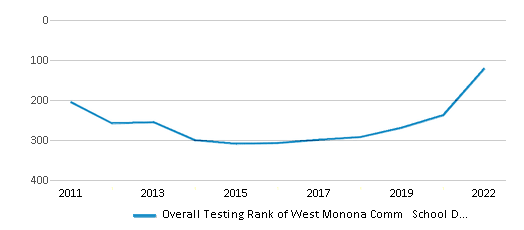
Math Test Scores (% Proficient)
66%
64%
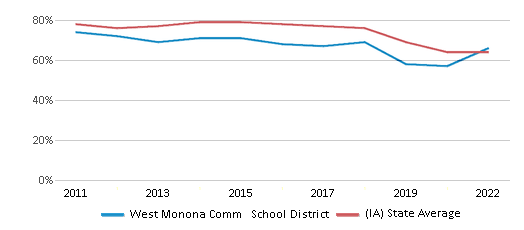
Reading/Language Arts Test Scores (% Proficient)
78%
70%
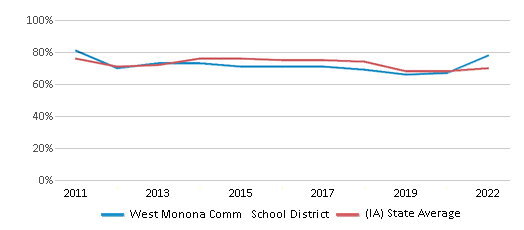
Science Test Scores (% Proficient)
60-64%
63%
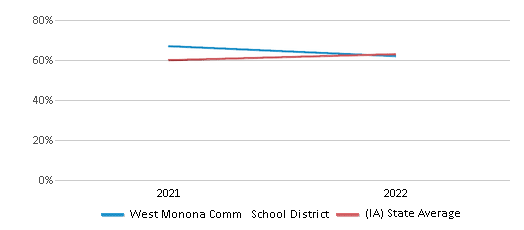
Graduation Rate
≥90%
90%

Students by Ethnicity:
Diversity Score
0.28
0.45
# American Indian Students
40 Students
532 Students
% American Indian Students
6%
n/a
# Asian Students
n/a
2,925 Students
% Asian Students
n/a
2%
# Hispanic Students
19 Students
18,818 Students
% Hispanic Students
3%
13%
# Black Students
6 Students
9,688 Students
% Black Students
1%
6%
# White Students
544 Students
111,231 Students
% White Students
84%
73%
# Hawaiian Students
1 Student
1,189 Students
% Hawaiian Students
n/a
1%
# Two or more races Students
35 Students
7,501 Students
% of Two or more races Students
6%
5%
Students by Grade:
# Students in PK Grade:
54
23,036
# Students in K Grade:
44
25,738
# Students in 1st Grade:
41
22,613
# Students in 2nd Grade:
59
21,812
# Students in 3rd Grade:
39
20,001
# Students in 4th Grade:
49
18,600
# Students in 5th Grade:
56
14,277
# Students in 6th Grade:
39
5,389
# Students in 7th Grade:
25
67
# Students in 8th Grade:
48
108
# Students in 9th Grade:
37
31
# Students in 10th Grade:
46
54
# Students in 11th Grade:
40
71
# Students in 12th Grade:
68
97
# Ungraded Students:
-
-
District Revenue and Spending
The revenue/student of $16,507 is higher than the state median of $16,468. The school district revenue/student has stayed relatively flat over four school years.
The school district's spending/student of $13,470 is less than the state median of $16,042. The school district spending/student has stayed relatively flat over four school years.
Total Revenue
$11 MM
$8,262 MM
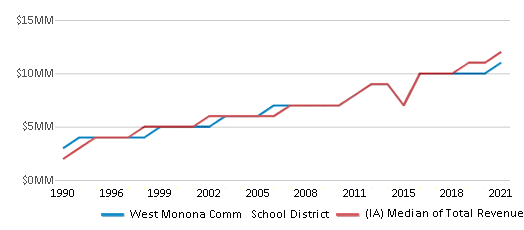
Spending
$9 MM
$8,048 MM
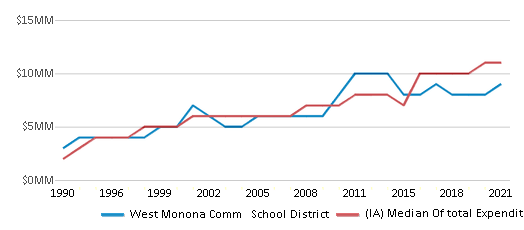
Revenue / Student
$16,507
$16,468

Spending / Student
$13,470
$16,042
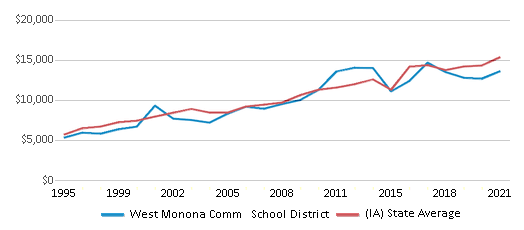
Best West Monona Comm School District Public Preschools (2025)
School
(Math and Reading Proficiency)
(Math and Reading Proficiency)
Location
Grades
Students
Rank: #11.
West Monona Elementary School
(Math: 65-69% | Reading: 75-79%)
Rank:
Rank:
7/
Top 50%10
611 4th Street
Onawa, IA 51040
(712) 433-1393
Onawa, IA 51040
(712) 433-1393
Grades: PK-5
| 342 students
Recent Articles

Year-Round Or Traditional Schedule?
Which is more appropriate for your child? A year-round attendance schedule or traditional schedule? We look at the pros and cons.

Why You Should Encourage Your Child to Join a Sports Team
Participating in team sports has a great many benefits for children, there is no doubt. In this article you will learn what those benefits are.

White Students are Now the Minority in U.S. 九游体育s
Increasing birth rates among immigrant families from Asia and Central and South America, combined with lower birth rates among white families, means that for the first time in history, public school students in the United States are majority-minority. This shift in demographics poses difficulties for schools as they work to accommodate children of varying language abilities and socio-economic backgrounds.





